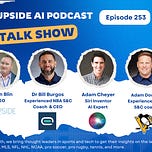Today as part of our continued effort on AI and the impact on elite sports, we have the honor to interview a interviewing a group of experts in AI and elite sports:
Dr Bill Burgos, the CEO of LONU a next generation AI based nutrition platform. Bill is also a highly accomplished strength and conditioning expert with extensive experience in the NBA, having served as the Head of Strength and Conditioning for the Minnesota Timberwolves, Orlando Magic, and New York Knicks.
Adam Cheyer, a renowned computer scientist and entrepreneur best known as the co-founder and original developer of Siri, the intelligent voice assistant later acquired by Apple in 2010. He was also a founding member of Change.org and has held key roles at companies like Viv Labs (acquired by Samsung) and SRI International. Cheyer is recognized for pioneering work in artificial intelligence, natural language processing, and human-computer interaction.
Jordan Stewart-Mackie, a performance scientist currently affiliated with the NBA Academy Africa, where he focuses on optimizing athlete development through tailored training and nutrition programs. Jordan has also served as an Applied Performance Scientist at Playermaker and has held roles in professional football clubs across Europe and Asia, including Buriram United FC and Leicester City FC.
Adam Douglas, the head S&C coach for the Pittsburgh penguins, an NHL team.
You can watch the video interview below by clicking on the Youtube link. You can also listen to the audio interview by clicking on the link at the top of the page:
You can read the full transcript of the podcast interview with Bill, Adam C, Adam D and Jordan located at the top of this blog post.
Here are the quotes from the interview with them:
Q1. How do you see Generative AI evolving over the next 2–5 years in elite sports and beyond?
Adam Cheyer (Co-founder of Siri):
“Today, most generative AI tools rely on pre-trained models and a simple chat interface. But over the next three to five years, I expect three major shifts. First, the interface will evolve. Just like the early web was static and eventually became interactive and commerce-driven, AI interfaces will become richer—blending graphical systems with natural language to better serve human users.
Second, AI needs to move beyond cached knowledge. Right now, these models don’t access live APIs or current data, which makes them outdated. Future AI systems need to know and do—interact with real-time data, execute actions, and learn dynamically. Third, we need to build an AI ecosystem—like the app ecosystems for mobile and web—so that brands, partners, and capabilities can plug in directly. It’s not just about crawling or scraping anymore. AI must enable direct collaboration with those who own the data and know the domain. That’s where the transformation lies.”
Adam Douglas (Pittsburgh Penguins):
“In elite sport, I want AI to be the eyes I don’t have. As a practitioner, I’m flooded with data—GPS from practices, biometric data from training, scouting reports from coaches—and I can’t possibly process everything. AI should be there to flag what I’m missing, filter the noise, and highlight trends I wouldn’t see on my own. But it’s not just about knowing—it’s about doing. When AI reaches the point where it can know and act in the same breath, while still allowing me to apply the sporting context, that’s when it becomes a true performance enhancer.”
Jordan Stewart-Mackie (EPL/NBA Performance Expert):
“We're not trying to replicate humans with AI—we’re trying to enhance our ability to represent human cognition in high-performance environments. AI’s role is to help us iterate, adapt, and innovate. It’s about bridging the gap between the instinctive and the analytical, helping us make smarter decisions while respecting the complexity of elite sport. The danger is when people think AI is about replacing the human side—what we’re really trying to do is augment it in the right ways.”
Q2. What are the most impactful AI use cases in elite sports?
Adam Cheyer:
“I think one of the most powerful applications is collaborative decision-making. I saw this firsthand when I was a guest coach for the Nigerian Olympic basketball team. Watching the coaches debate who to bring to the Olympics was fascinating—it’s all about trade-offs: youth vs. experience, speed vs. leadership, chemistry vs. individual skill. Imagine having AI tools that don’t just give you data, but help you understand where disagreements lie within your staff and pinpoint what decisions need deeper analysis. Decision-making in sport is rarely individual—it’s collective. AI can support that collaboration in ways we’ve never seen before.”
Jordan Stewart-Mackie:
“There are two big areas: First, real-time decision-making under pressure. In elite sport, everything is fast, complex, and constantly changing. AI can help us cut through uncertainty in the heat of the moment—during a game, during recovery, during return-to-play scenarios. Second, talent identification. With the rise of pattern recognition and large datasets, AI can spot potential in ways human scouts can’t. But it’s not just about identifying talent—it’s about customizing development pathways, saving time, and making better long-term bets on athletes. That could transform recruiting and player development.”
Adam Douglas:
“For me, the key benefit is time and cost efficiency. A few years ago, we were deciding whether to build out our analytics internally or work with an AI vendor. Hiring new staff and building models in-house would’ve taken years and cost hundreds of thousands of dollars. With a vendor, we could access a mature platform immediately. And in elite sports, where every hour counts, being able to turn around actionable insights in real time is worth its weight in gold. AI doesn’t just replace time-consuming tasks—it frees us up to focus on the human aspects of coaching and decision-making.”
Bill Burgos:
“People often overlook the human element in all this. AI is only as good as the people feeding it. Who’s labeling your datasets? Who’s interpreting the information? That matters. If you don’t have qualified strength coaches, dietitians, or PTs involved, you’re not getting the best out of the technology. So for me, AI is a support tool—but the real differentiator is the practitioner. The more we invest in the people who understand both performance and AI, the more useful those tools become.”
Q3: What specific use cases do you believe will have the biggest performance or competitive impact in elite sports?
Adam Cheyer:
“One of the most powerful applications of AI in elite sport is collaborative decision-making. I had the chance to be a guest coach for the Nigerian Olympic team and sit in on roster decisions. It was fascinating — trade-offs between veteran leadership and athletic youth, positional balance, role diversity. It’s all incredibly nuanced. What struck me was how valuable it would be to have tools that surface fine-grained disagreement and trade-off zones among coaching staff — tools that don't just show data, but help experts deliberate and make collective, optimal choices. Every organization makes hundreds of decisions like these — from lineup selections to rehab timing — and AI can become a real-time facilitator of smarter, more aligned decisions.”
Jordan Stewart-Mackie:
“There are two big domains where I think AI will have a transformative effect.
First, in decision-making under uncertainty — not just in training or planning, but in the moment. The game is chaotic, time-pressured, emotionally charged. AI could help filter and prioritize the right information so coaches make better live calls without being overwhelmed. Second is talent identification. The ability of AI to analyze large datasets, recognize subtle performance patterns, and project long-term growth is huge. But it’s not just about discovery — it’s about building individualized development pathways with more efficiency and precision. That will reshape the way teams recruit and groom talent.”
Adam Douglas:
“For me, it’s about time, efficiency, and money. I remember our analytics director saying, ‘We can either pay this vendor $50,000 or spend 10x that amount hiring someone, training them, and waiting two to four years to build the infrastructure ourselves.’ That was eye-opening. Teams are under pressure to make fast, high-quality decisions. And AI can massively reduce the turnaround time between collecting data and making use of it. Whether it’s training loads, rehab monitoring, or player profiling, having that speed gives you a real competitive edge.”
Bill Burgos:
“The big one for me is the human layer around AI. AI might process tons of data, but it doesn’t understand the culture of a locker room or how to connect with a player. When wearables first came to the NBA, players thought we were using the data against them. There was no trust. Now, the CBA requires us to explain exactly what metrics we’re using, why, and how it benefits the player — in layman’s terms. The future of AI in sport depends on educating athletes and earning their buy-in. If you get that right, AI becomes a powerful tool. If not, it becomes a distraction.”
Q4: What are the biggest limitations or risks of applying AI in high-performance settings like pro sports?
Adam Cheyer:
“There are three critical limitations:
Accuracy — these models are trained on massive amounts of data, but when they don’t know something, they tend to guess. They hallucinate. That’s dangerous in high-stakes decisions.
Transparency — these systems are black boxes. Even when you ask why they gave a certain output, they’ll invent a reason. Press refresh and you’ll get a different explanation. That undermines trust.
And third, they lack true human context and experience. They don’t understand what it means to compete, to be injured, or to feel pressure. That’s why human judgment will always matter. You should treat AI like a smart intern — useful, but not yet fully reliable.”
Adam Douglas:
“The biggest issue is data quality and standardization. Take hockey, for example. Wearables weren’t even formalized in the CBA until two years ago, and now we have a league-mandated system that teams are required to use — but we don’t really know how valid or reliable it is. If I don’t trust the input, I can’t trust the output. Worse, if my data and another team’s data are processed differently, how do we train models that work across organizations? Even within one club, if we’ve only got three years of clean, trustworthy data, we’re building AI on a small foundation. Garbage in, garbage out. That applies even more in elite sports, where margins are razor-thin.”
Bill Burgos:
“AI is only as good as the practitioners who use it. When I was finishing my doctorate, I studied electronic medical records — and the biggest cause of system failure was user error. Same thing with AI: if the data going in is mislabeled, incomplete, or interpreted wrong, your entire model is flawed. And then there’s the player interaction piece. In the NBA, I had athletes who responded totally differently to the same feedback. AI doesn’t know your players — you do. So if you’re not tailoring your communication and engagement around those human factors, you’ll lose buy-in. AI can’t replace the coach–player relationship — it can only support it.”
Jordan Stewart-Mackie:
“One of the biggest risks is when players self-interpret AI insights without context. I’ve seen athletes change their training plans because a wearable said something — even when it wasn’t the right move. With money and private trainers, they go off-script and potentially harm themselves. We need to train athletes to own their data responsibly and understand what it means in context. AI might give us the data, but we need to shape the behavior. And that only happens with education, clarity, and trust in the system.”
Q5: How should professional teams and federations structure their AI strategies? Should they build in-house, partner with startups, or use off-the-shelf platforms?
Adam Douglas:
“We were seriously weighing whether to build AI capabilities in-house or partner with an external company. Internally, building out analytics from scratch meant hiring full-time staff, training them, designing models, and waiting years to see results. It was going to cost 10 times more than what a vendor was offering.
But we also had to factor in data privacy and league regulations. In hockey, the CBA is still playing catch-up, and there are limitations on what data can be shared. So while external vendors offer speed and cost efficiency, they also bring concerns around ownership and control.
The best approach right now is a hybrid model: teams partner with proven vendors who already have the infrastructure but stay vigilant about how the data is used and who has access.”
Adam Cheyer:
“AI will be used across every function in an organization — not just performance. From marketing to HR to scouting, it’s going to touch everything.
Some departments can absolutely use off-the-shelf tools like ChatGPT or Copilot. But when it comes to sport-specific performance use cases, like injury forecasting or lineup optimization, you’ll need vendors who understand the sport deeply. That’s where startup partnerships shine — they’re agile, they iterate quickly, and they solve niche problems.
The key is for teams to develop a clear AI vendor qualification framework. Who are the best partners? What’s their track record? How do they handle sensitive data? The answers to those questions will shape your long-term AI strategy.”
Bill Burgos:
“Startups are great in theory — but they can add to your workload instead of reducing it. I’ve been in situations where a company made big promises, got us excited, and then a year later, we were still waiting for something usable. Meanwhile, I was doing twice as much work trying to support them.
So my checklist now is:
What have you already built?
How fast can you deliver?
Will this simplify my day-to-day or make it more complicated?
Time and simplicity matter in sports. We don’t have the luxury to wait.”
Jordan Stewart-Mackie:
“For me, the most important piece is contextual alignment. If you’re going to use AI models, they must reflect the specific characteristics of your environment — your athletes, your processes, your coaching philosophy.
That’s why in-house models can be powerful — they include the errors, anomalies, and learnings that are unique to your team. But not every team has the capability to build those. So it’s about striking the right balance: partner with vendors when it makes sense, but don’t become totally dependent on them. Otherwise, you lose your ability to adapt, and you’re at the mercy of someone else’s roadmap.”
Q6: What skills or roles will become essential as AI becomes more embedded in elite sports and business?
Adam Cheyer:
“The number one shift is that every job will evolve. Whether you’re in scouting, fan engagement, or coaching — AI will become part of how you work.
The key skill is learning to use AI as a co-pilot. That means knowing how to prompt it, how to interpret results, how to validate outputs, and how to integrate its suggestions without blindly following them.
And yes, kids are already learning this. In China, they’re starting AI education at age six. That’s why I always say: AI won’t take your job, but someone using AI will. You want to be that someone.”
Adam Douglas:
“It’s like the early internet days. At first, some people resisted it — now no one can do their job without it. AI will follow that same curve. It’s already showing up in emails, calendars, scouting systems, and player management software. The difference is, practitioners who embrace it now will be the ones who lead later. And those who resist it will fall behind. It’s coming — it’s not optional anymore.”
Bill Burgos:
“I’ve worked with both the oldest and the youngest teams in the NBA, and the difference is stark. The older players didn’t grow up with tech, so there was skepticism. The younger guys? They’re digital natives. They’re already asking deep questions about AI, training loads, recovery data — at age 15. That’s the future. In five years, the NBA, NFL, and NHL will be filled with athletes who expect tech integration. So if you’re a practitioner and you’re not learning how AI works, you’re going to be disconnected from your athletes.”
Jordan Stewart-Mackie:
“The biggest long-term value of AI isn’t in stats — it’s in how it enhances human growth. If used properly, AI helps us learn faster, think deeper, and become more creative. That’s where the edge is — not in automation, but in evolution.
We need to train ourselves and our athletes not just to use AI, but to understand it, question it, and apply it wisely. That’s how we unlock its full potential.”
You may also like:
📈 Upside Analysis: Enhancing, Not Replacing: How AI Empowers Practitioners in Elite Sports
Artificial Intelligence (AI) is rapidly transforming elite sports, offering tools that elevate training, recovery, performance analysis, and tactical planning. Yet, one major misconception persists: that AI threatens to replace human practitioners. In reality, AI’s true value lies in its ability to
Upside: How AI is reshaping pro sports
AI start-ups received funding worth $89.2 billion from 6,786 VC investors during 2021, which is the highest among all the technology themes. As a result of that AI has become a hot topic in the investment and the tech community as a whole.













